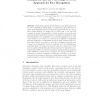Free Online Productivity Tools
i2Speak
i2Symbol
i2OCR
iTex2Img
iWeb2Print
iWeb2Shot
i2Type
iPdf2Split
iPdf2Merge
i2Bopomofo
i2Arabic
i2Style
i2Image
i2PDF
iLatex2Rtf
Sci2ools
ICIAP
2005
ACM
2005
ACM
Asymmetric 3D/2D Processing: A Novel Approach for Face Recognition
Facial image analysis is very useful in many applications such as video compression, talking heads, or biometrics. During the last few years, many algorithms have been proposed in particular for face recognition using classical 2-D images. Face is fairly easy to use and well accepted by people but generally not robust enough to be used in most practical security applications because too sensitive to variations in pose and illumination. One possibility to overcome this limitation is to work in 3-D instead of 2-D. But 3-D is costly and more difficult to manipulate and then ineffective to authenticate people in most contexts. Hence, to solve this problem, we propose a novel face recognition approach that is based on an asymmetric protocol: enrolment in 3-D but identification performed from 2-D images. So that, the goal is to make more robust face recognition while keeping the system practical. To make this 3-D/2D approach possible, we introduce geometric invariants used in computer vision...
Face Recognition | Face Recognition Approach | ICIAP 2005 | Image Processing | Robust Face Recognition |
| Added | 08 Dec 2009 |
| Updated | 08 Dec 2009 |
| Type | Conference |
| Year | 2005 |
| Where | ICIAP |
| Authors | Daniel Riccio, Jean-Luc Dugelay |
Comments (0)

